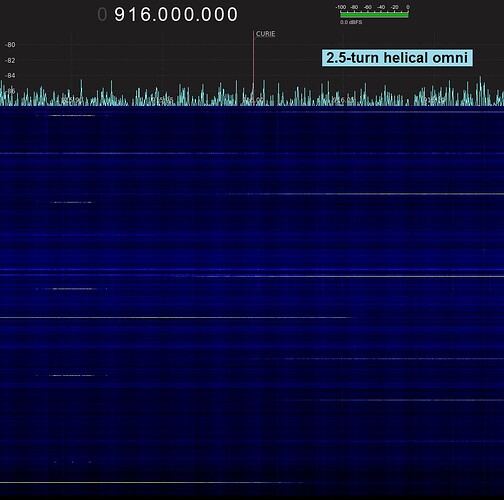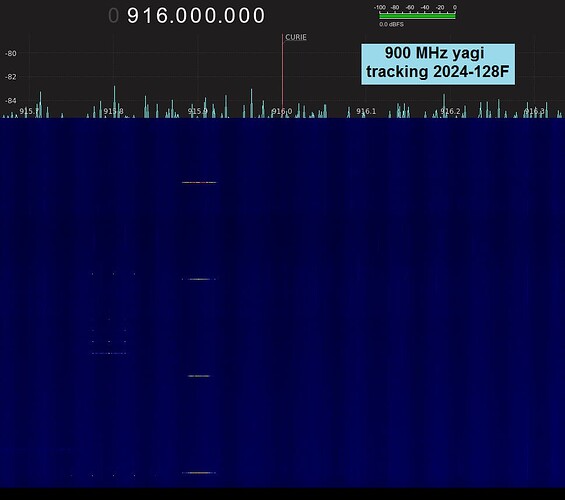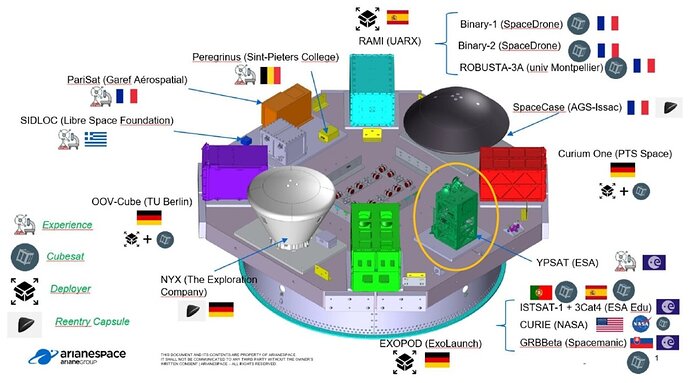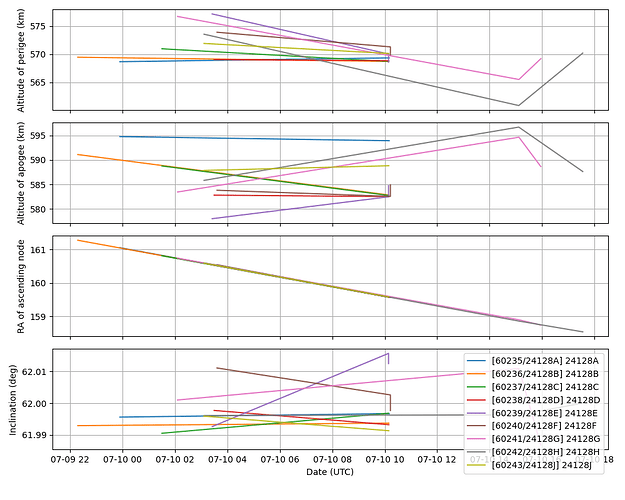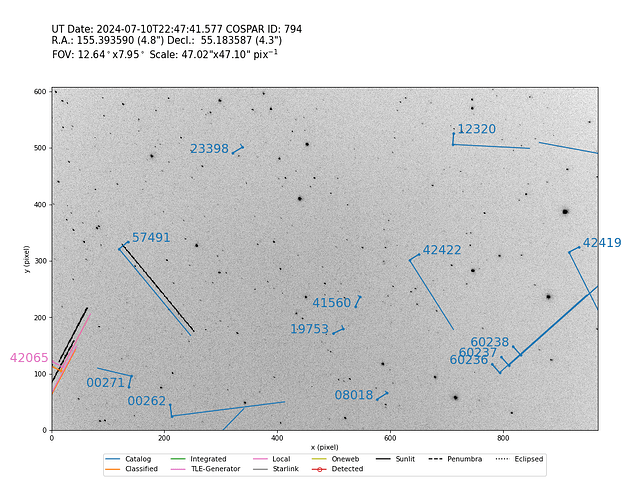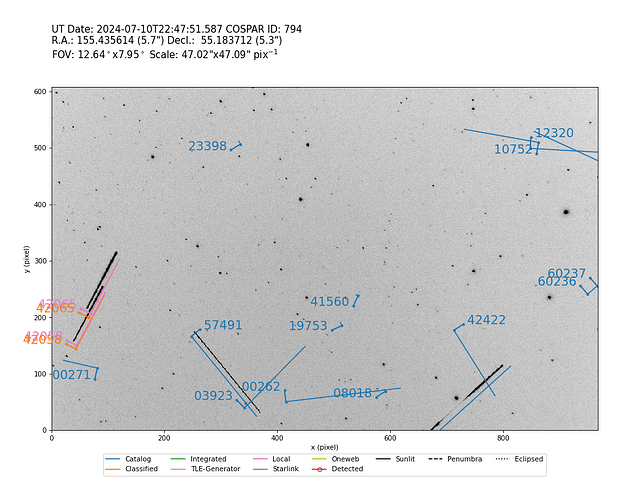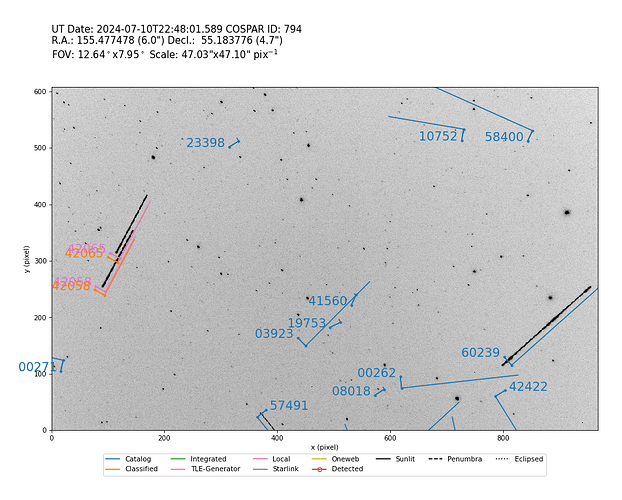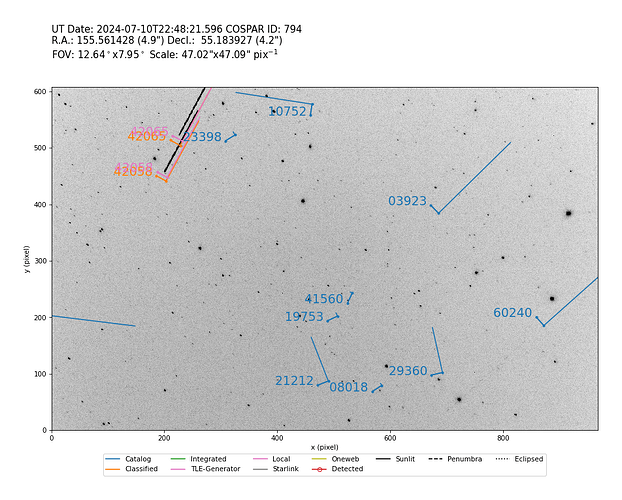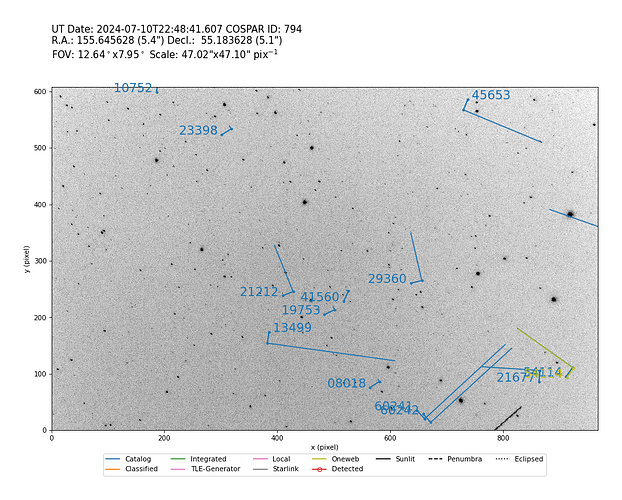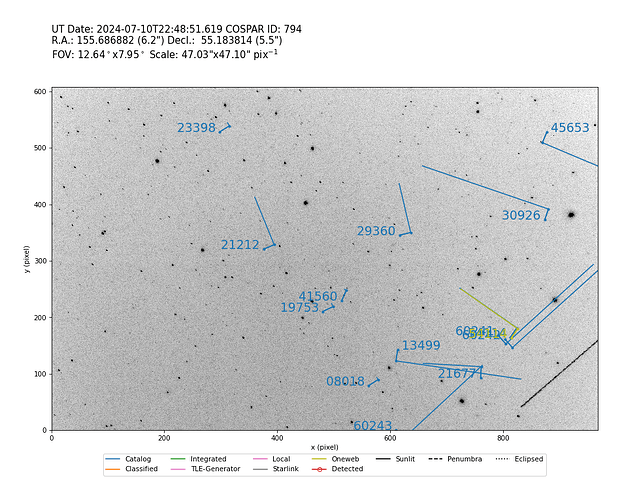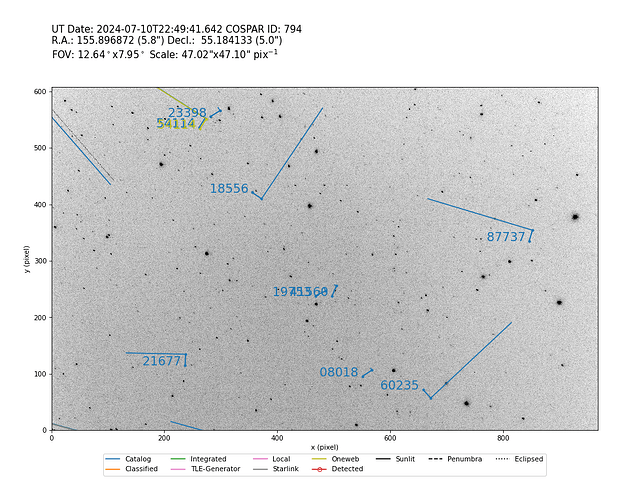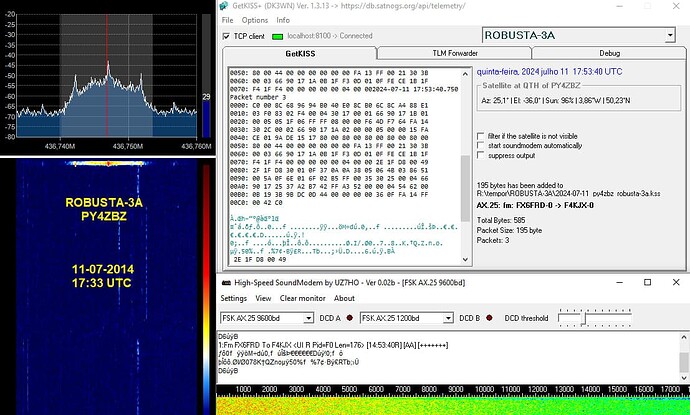In addition to the perfect list of questions posted, do you have any idea yet which NORAD number(s) are tracking to most likely be CURIE?
Hi Scott,
Follow Cospar 2024-128, currently 9 objects with the TBA - TO BE ASSIGNED status
Aye, thanks for answering so quickly. Let me go through your questions here:
- Are more than one CURIE satellites?
We launched as one unit, that will later separate into two satellites. Currently they are merged, but both of them should be on and broadcasting together.
-
Can you confirm the frequencies that they transmit at 916 MHz and at 2395.000 MHz?
We currently only sending on 916 MHz. The S-band is turned off during early commissioning.
-
When you say “we are sending beacon”, you mean from earth to space? or that the satellites beacon (from space to earth)?
The satellites are sending the beacon from space to earth. (The royal satellite we, I guess)
-
Are the satellites beaconing or transmit only over command, or maybe only over a specific area?
They are beaconing continuously, at once per minute interval. I expect both satellites to be somewhat offset just due to bootloader.
-
Do you need support from ground segment on reception only, or on transmission too?
For now, receiving would be phenomenal. Our ground station should come online by next week, bringing back our receive and transmit capabilities.
And lastly, your guess is as good as mine for the NORAD numbers.
Chris
Thanks for the answers!
There are not many stations in the Network that support 916 MHz frequency and those that support it are not set for exactly that frequency. However we’ve scheduled them and if we have any news we will update this thread.
Maybe some of the 3rd party observers/stations here could also help.
I am setup with a variety of options for 900 MHz, so will definitely put a priority on CURIE.
I see the 916 beacon listed as 87k GFSK.
Do we have, or can we please get the additional info such as how to deframe the packets, or whatever additional info is needed to decode the payload bytes? Packet size expected? An example decode packet would be wonderful - an audio or I/Q sample file would be even better!
Thanks!
2230utc pass of these objects over the Eastern U.S. monitored 916 MHz for CURIE w/ both a helical omni + a 900 MHz yagi tracking object ‘F’ (because it was in the middle of the pack). No signals seen w/ any doppler, but max EL was only ~40°, so if the TX power is very low perhaps I’ll need more elevation. Will keep trying!
YPSAT is bolted to the Ariane 6 payload adapter and was not deployed. Data&Images were transmitted on 2.44 GHz in the amateur satellite band (IARU coordinated).
The Upper Stage was supposed to be de-orbited after the 3rd orbit, thus YPSAT does not have solar cells and the battery should last about 3 hours or so, but should be depleted by now.
Unfortunately there was a problem with the re-ignitable propulsion system and the de-orbit maneuver was cancelled, immediately after the mishap the upper stage was “passivated” will remain in orbit for many years.
It looks like we had TLE Swaps:
After the swaps the only non TBA(To Be Assigned) object is 60235 which is 99% the upper stage. For the rest we still have TBA status, which means that they may swap/change again.
So, here is the status update taking into consideration these swaps:
| Temporary NORAD ID | Satellite | NORAD ID to follow | Other NORAD IDs | Identified | Deployed | Last Update |
|---|---|---|---|---|---|---|
| RECEIVED AND DEMODULATED | ||||||
| 98877 | ISTSAT-1 | 60236 | 60237, 60238 | NO | YES | Received and Decoded, changed to follow 60236, other possible 60237, 60238, removed 60239, 60241, 60242, 60243 |
| 98882 | GRBBeta | 60237 | 60236, 60238 | NO | YES | Received and Decoded, changed to follow 60237, other possible 60236, 60238, removed 60239 |
| 98895 | ROBUSTA-3A | 60243 | - | NO | YES | Received and Decoded, changed to follow 60243, removed 60235, 60236, 60236, 60242 |
| RECEIVED | ||||||
| 98878 | 3CAT-4 | 60238 | 60236, 60237, 60238, 60239(unlikely) | NO | YES | Received, continue to follow 60238, other possible 60236, 60237, 60238, 60239(unlikely) |
| 98880 | Ariane 6 - Upper Stage | 60235 | All other(unlikely) | NO | YES | Received SIDLOC payload, continue to follow 60235 with more confidence, other possible All of them but unlikely |
| NOT RECEIVED | ||||||
| 98875 | Replicator (ORBIT-3D) | 60239 | All | NO | YES | Not Received, randomly assinged to follow 60239, other possible All of them |
| 98876 | OOV-Cube | 60243 | All | NO | YES | Not Received, randomly assinged to follow 60243, other possible All of them |
| 98881 | Curium One | 60242 | All | NO | YES | Not Received, randomly assinged to follow 60242, other possible All of them |
| 98879 | CURIE | 60240 | All | NO | YES | Not Received, randomly assinged to follow 60240, other possible All of them |
| NOT IN DB | ||||||
| SpaceCase SC-X01 | - | NO | UNKNOWN | |||
| NyxBikini | NO | UNKNOWN |
Hello everyone!
Adrian from 3Cat-4 here. We are having some issues with out battery, and it seems like the satellite went into critical mode due to a low battery level, and stopped transmitting the beacon. We were able to successfully receive some of the beacons and confirm the battery readings.
We are also working on releasing the decoder for the satellite, but it’s taking us some time as our GNURadio is ancient. Importantly, our modulation is GMSK 14400, not 9600.
If you receive any beacons as raw data and want to help us follow the status of the satellite, you can reach the team at join (at) nanosatlab.space.
Best regards,
Adrian.
Thanks for the update @aperz and welcome to the community!
I’ve changed in SatNOGS DB the baudrate and it has also updated on the future scheduled observations in the Network.
Last night have optically observed the Ariane 6 mission. Here are the pictures. The Object numbers should be taken with care as this how they were at dusk. They might have changed later due to id swapping by Space Track.
First 3 objects (60238, 60237, 60236) in lower right are close together and are invisible. I guess they are smaller objects, that come from the same deployer:
Next one (60239) is flashing and varying in brightness as seen in the next two pictures. It is probably tumbling, and it could be the Ariane 6 Upper stage. But I am not sure yet! (On the left is a classified NOSS pair)
Then we get Object 60240, which looks invisible at first sight, but in the second picture there is a very very very faint trace running late on the predicted position.
Next one was a bit off track, to 60241, 60242. It is very bright and steady, likely one of the bigger satellites:
Last two (60243, 60235) were invisible:
I hope the optical properties of the objects can help in the identification!
If it doesn’t contain any black magic, perhaps try to write a satyaml for it and be done. If you want help with that, just reach out, we’re a few that does this on a regular basis.
The only black magic is that we use the FEC plus whitening of the CC1101 that i believe is not compatible with gr-fec from what we saw. But I can check it out.
Best regards!
Did you re-use code from 3CAT-1 and or 3CAT-2 ?
I tried the deframer that are part of those older satellites, but with no success.
Here is the code of that deframer gr-satellites/python/components/deframers/sat_3cat_1_deframer.py at main · daniestevez/gr-satellites · GitHub
Maybe the sync word has changed, but I also saw a mention of FEC in one of the SatNOGS channels.
Hello! Afonso from ISTSAT-1 again!
We are still facing some issues with our groundstation but we’ve been able to receive more beacons. It seems that the main issue for us now is that the TLEs are too far off for us to reliably capture data.
We’ve collected some short and long beacons that can help calculate new TLEs from the doppler.
Our groundstation is not integrated into satnogs, but I’ll leave some download links for two IQ file captures where the beacons can be seen. These were captured using GQRX @ 500kHz sampling rate.
- 3min30 @ 145.899 (short)
- 4min30 @ 145.898 (short)
- 5min40 @ 145.897 (long)
- 8min05 @ 145.895(short)
- 1min50 @ 145.897 (short)
- 3min @ 145.897 (short)
- 4min05 @ 145.897 (short)
- 5min10 @ 145.896 (long)
- 11min @ 145.891 (long)
- 12min15 @ 145.891 (short)
We are currently seeking help generating new TLEs from this data. Any help is much appreciated. Some signals are very weak, but hopefully they’re good enough.
We are now busy extracting the tlm data from the long beacons.
Cheers! o7
AM
Hi Alfonso!
I think you should try to fit your recording with Cees Bassa’s strf suite and generate a TLE from it.
It may seem difficult to use at first glance, but Daniel Estévez has made a great post to start using it.
Nevertheless, I’m sure some of the forum users have a lot of experience with the tool, but for better fit, a location for the recording site (the ground station) would be appreciated.
Hope this helps.
Best regards!
From the latest analysis on the Network observations ISTSAT-1 should be one of the objects 60236, 60237 or 60238.
Whichever you track you should have good results as they are very close to each other.
It was a new codebase. I am attaching the relevant files in case someone more proficient in gr-fec knows if they’re compatible, but I think using a constraint length of 4 is not.
Thanks for sharing this information,
Now that 3CAT-4 is not being active, can you also share a recording so we can test decoder development?
